Today, an interview with a beloved beta reader of mine, Andrew. Andrew’s a voracious reader and so let’s learn a little more about his reading habits.
Tell me a little about yourself?
What are you currently reading?
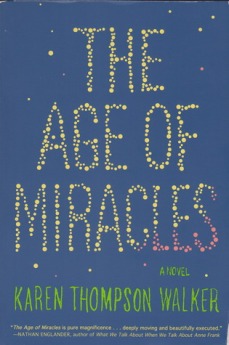
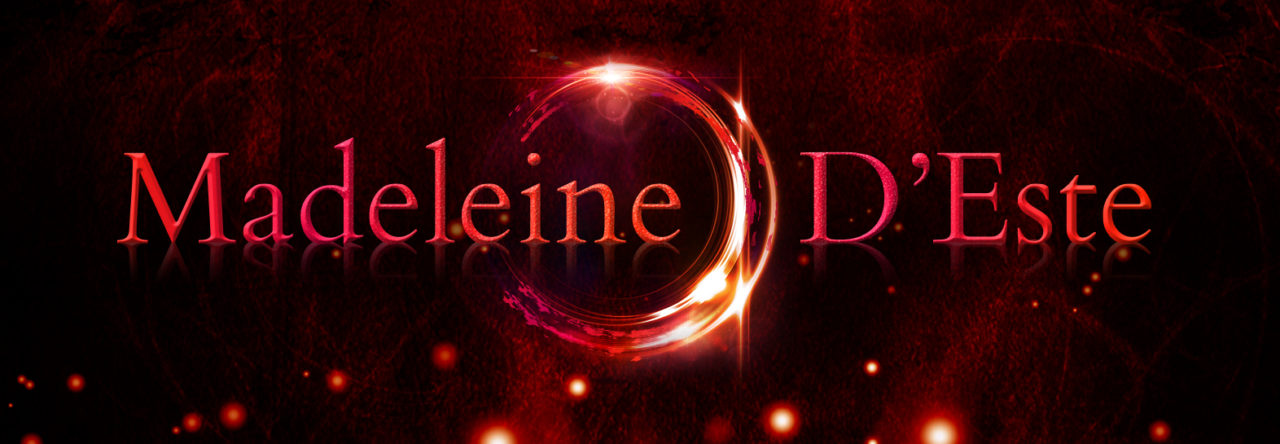
Today, an interview with a beloved beta reader of mine, Andrew. Andrew’s a voracious reader and so let’s learn a little more about his reading habits.

In an ideal world, my writing space would be in a room overlooking craggy cliffs.
The floor to ceiling windows would open out to the sea, where I’d watch the ever-changing weather roll in and the waves crash against the rocks. I’d be inspired by the power of nature, the wild and moody weather.

Unfortunately named “Suicide Cliffs” in Okinawa
Why did I love Europe in Autumn by Dave Hutchinson so much?
The book is a spy thriller set slightly in the future, in a time when the countries of Europe is dissolving. Every man and his dog is seceding, setting up their own principality. Borders are a bureaucratic nightmare and black marketeers are taking advantage of the chaos.
The hero is Rudi, an Estonian chef turned courier, who gets deeper and deeper into the murky world of espionage.
The book is in four parts following Rudi from his first gig until the point when it all goes wrong. It is almost like four novellas, pieced together eventually. The middle section with Rudi’s family in Estonia seems out of step at first until more details are revealed. I adored the excerpt from the map-making of Whitton-Whyte and the twist delighted this little sci-fi fan.
Why did I enjoy this book so much?
Perhaps it was the mix of vivid characters; the burly Hungarians, the obnoxious mentor Fabio, Rudi’s bizarrely robotic English captors, the grumpy crusty Pawel. The characters were well rounded and real.
Perhaps it was the slight weirdness of the world. Quite similar to our own, yet with minor technological and geo-political differences.It was familiar and yet intriguing. There was little time spent world building, the story jumps right in and explains the world as we go. Yet there are enough odd little details to remind the reader that this is not your ordinary Tom Clancy thriller.
Perhaps it was the wry English humour. The dialogue was sharp and believable. I chuckled out aloud a number of times.
Plus a cracking plot.
Let’s just say, I really liked this book.
But the topic of genre provoked the most thought for me. This is classified as a science fiction novel – which it is. The world is futuristic, but only looking a few years into a possible future. I was so curious about the genre of this novel, I contacted the author. I had a nice conversation with Dave Hutchinson over Twitter regarding the genre classification of this book. Hutchinson describes it as a “near-future espionage thriller”. This is a very apt description.
I struggle with the “science fiction” label because it brings to mind aliens and spaceships. My own writing is in a similar vein to Hutchinson’s – a different world not too dissimilar to our own. Is speculative fiction a better description or “fantastika” as Hutchinson offered? Yet, your average punter doesn’t use the expression ‘speculative fiction’. When I look at the categories for sci-fi in Amazon, the only vaguely applicable are “dystopian” and “post-apocalyptic” but my own writing and a book like Europe in Autumn does not fit with the other zombie invasion novels.
Anyway less about me and more about Europe in Autumn. If you like a well built near-future world with espionage, great characters and good writing, I recommend you take a look at Europe in Autumn.
I’m off to read the sequel…when I’ve finished The Wise Man’s Fear.
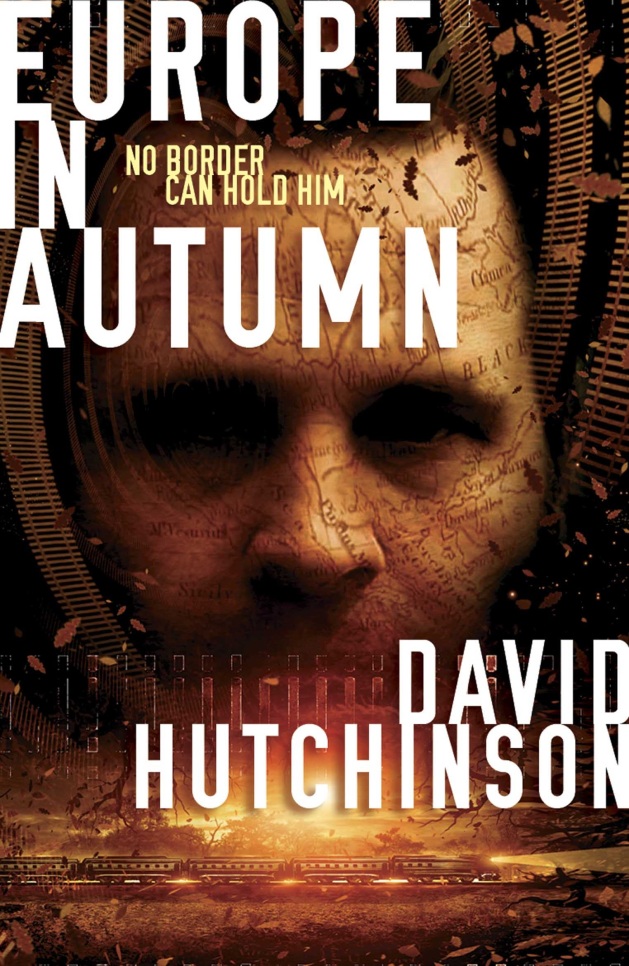
Today, I thought I’d share the first page of my steampunk novella set in Marvellous Melbourne in 1880s, Evangeline & the Alchemist.
I hope you enjoy….
Chapter 1
It all started with a rat-a-tat-tat on the Professor’s laboratory-workshop door. Evangeline and the Professor looked up from their inventing to see Miss Plockton in the doorway.
“Chief Inspector Pensnett ta see you, sir?” she said.
Evangeline perked up on her stool. A policeman here at 56 Collins Street? Something exciting was surely about to happen.
“Ah, yes. I plum forgot.”
Evangeline’s father stopped adjusting his new, improved auto-chariot and walked over to the wooden bench, placing his trusty brass screwdriver with the ivory handle down beside neat stacks of brass cogs, wheels and pins. Her father, Professor Montague Caldicott, the pre-eminent horological-engineer in all the Colonies, smoothed down his humongous moustache with his real hand.
“Your lesson is over for today, m’dear. Follow Miss Plockton upstairs and continue with your embroidery.”
“But Father…” Evangeline groaned. “I could be of some assistance.”
“Police matters are not for the ears of impressionable young ladies. All those dead bodies and smugglers and swarthy criminals. Far too sordid.”
“I never get to do anything interesting,” Evangeline grumbled as she stowed away her rosewood-handled screwdriver in the pocket of her dress, along with a handful of brass pins. The smaller and more delicate screwdriver was a recent gift from her father, an encouragement to pursue her own inventions.
Evangeline’s plain bottle-green day dress, buttoned to the neck, was not the latest fashion but it was better than she had ever imagined in her previous life on the grey foggy streets of London, when her toes poked through holes in her boots. Cold was something she had yet to worry about since she arrived three months ago on the dirigible from Singapore. She wondered whether Melbourne could be anything less than sweltering.
“Out. Out.”
The Professor shooed Evangeline and Miss Plockton from the laboratory-workshop, before carefully locking the door behind him.
There was a time when a visit from the police would have frightened Evangeline. She would have hurried to hide her loot, but not today. Today she was a reformed character, setting aside her urchin ways and learning to be a proper young lady. But being good all the time was a bit dull.
Evangeline and the Alchemist is now available on Amazon.
Writing Challenge participant Natalie K challenged me to the 7/7/7 Snippet Challenge.
The rules are:
Here are the 7 lines from the 7th row of the 7th page of my recently “completed” manuscript, Return to the Monolith. I’m stoked to announce, I’ll start querying agents with Monolith from early January. Hoorah! But here’s a sneak peek.
Dawn peeked through the pink-fringed grey clouds, lighting up the sky in the east. The snow-tipped mountains loomed in the distance. Alga’s heart pounded. This was the first time she had ever walked away from her mountains.
Her stomach had stopped rumbling. Her tears dried up. She tried not to think about her Sisterhouse and what she had left behind.

Now, I am passing on the fun to seven more writer bloggers. Consider yourselves challenged;
Looking forward to seeing other 7/7/7 Snippets.
It’s the time of year between Christmas and New Year, like the lull between two waves. Time for planning and reflecting.
Here are the three writing tips I learned in 2015. These three tips definitely made me a better writer.
*Disclaimer – I can’t remember where I got these tips from. If it was you, thanks and sorry.
Let’s get specific. Lazy writing is full of things, stuff and them. This year I learned to be specific about what I am writing. In 2015, I got out my nouns. First drafts can be full of vagueness but once the red editing pen comes out, it’s time to be precise. But specificity must be paired with tip#2, otherwise the words will grow and multiply like mice. And there’s nothing worse than a mouse plague…shudder…
Why use ten words when you can use two? My writing style is simple, mainly because I don’t like verbose writing personally, but this year I learned to use embrace the simple (and specific). Why use an adjective when I can find the right verb? He didn’t walk, he strutted, she plodded, we ambled. There is more power in brevity.
Like botanical illustrations, I strive to be both simple and specific.

The third tip is about dialogue. Any scriptwriter knows this stuff but it was a revelation for me. This year I learned that each character has their own agenda in any conversation. Everyone has their own desired outcome from any discussion and our agendas will clash. This tip has helped me to stop my dialogue from being an exposition fest
In normal conversation, there are misunderstandings and confusing conversations when someone doesn’t say what they actually mean. There are a myriad of reasons why we don’t speak our minds. This is also true in dialogue. Each character is reading from their own script and the scripts don’t match.
I am boringly conscientious. It was always on my school report…Madeleine is a conscientious student. But stuff still distracts me from writing.
I live in an area filled with older homes under renovation. If the gentle roar of power tools isn’t coming from my own house, it’s one of my neighbours drilling, sawing or generally banging loudly.
Headphones are good.

I’m not alone. I know the blasted internet and social media call to us all. Distract me. Validate me. Just check the weather. Maybe someone liked my tweet. A quick look at the news. Next thing I know, it’s thirty minutes later. Damned instant access to everything ever.
Unfortunately I’m not independently wealthy or a kept woman, so I have to work. This is a major distraction from writing. Although perhaps with more time on my hands to write, there’d be more opportunity for other distractions to creep in.

Note to self – occasionally stop writing and socialise. While Mr Madeleine and friends are a lovely distraction, if they interrupt at the wrong moment, they are in danger of encountering extreme grumpiness. As with many things, timing is important.
I often talk about Resistance. The little evil man on my shoulder telling me I’m crap and I’m wasting my time with this writing stuff. He is the root cause of most of my writing distractions.Some days he is stronger than others. I try to ignore his little snarks and keep putting my fingers on the keyboard.
In early December, I ran a series of posts asking writers…
When did you feel like a “real” writer?
I was lucky enough to get responses from Gail Carriger, Val McDermid, Joanne Harris, Ben Aaronovitch, Victoria Schwab, John Scalzi, Kim Newman, Neil Gaiman, Joanna Penn, Mark Dawson, Barbara Freethy and Kate Elliott.
There were a few themes running through the responses
But mainly, you are a real writer when you write….
Villains. We need them.
We need the villain to threaten our hero. We need our villain to be strong and clever. We need her to give our hero a hard time. Villains add colour and complexity to our stories, they bring the complications.
But when I thought about villains, only the scary characters came to mind. Those men and women who send shivers down my spine. And one man jumped into my mind.
This is not my favourite villain for his intelligence or his outwitting of the hero. He brings no witty retorts. He just scares me like no one else can.
I bring you.
Bob from Twin Peaks.
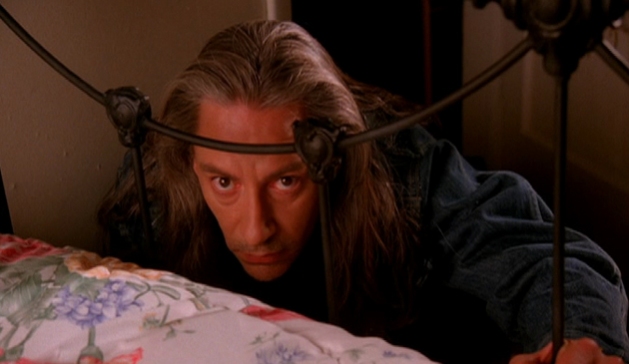
Excuse me while I go and hide behind the couch…..
Here are seven random facts about me.
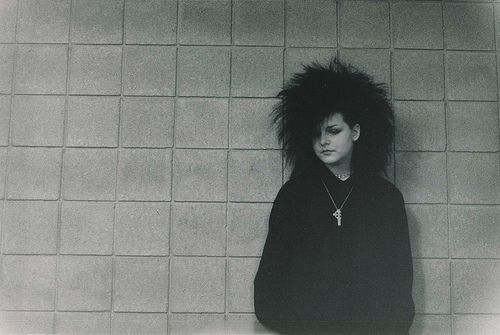
(This is not me)

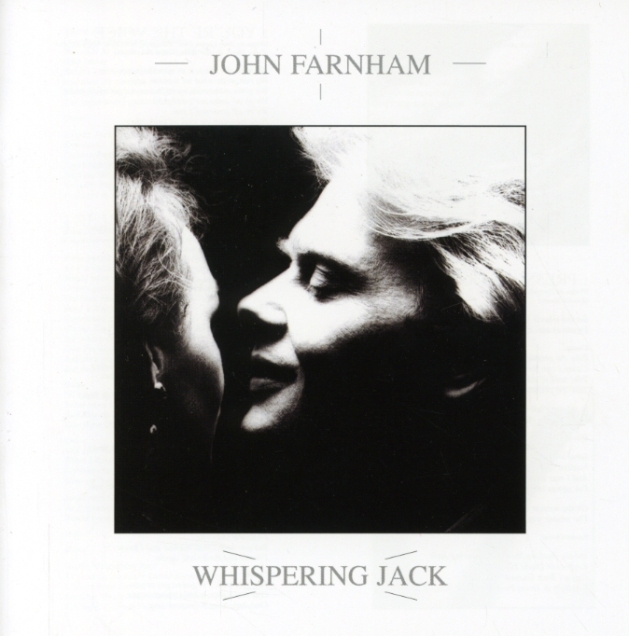
How do I approach naming my characters? Today I’m answering a few questions on character names from AJ Lundetrae.
Chanel, Dior, Lagerfeld, Givenchy, Gaultier, darling. Names, names, names!
Edina Monsoon, Absolutely Fabulous
Names are very important to me.
I was a strange child and completely obsessed by boarding school books (especially the Chalet School). Using my illustrated atlas and a reference book of names and their meanings, I created my own school rolls. Lists of girls names and their exotic home cities.
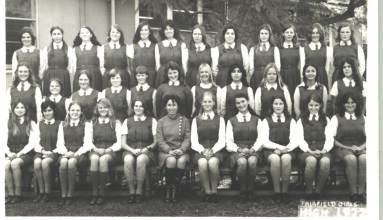
A name tells you a lot about a person’s past, their heritage, their social position. Names are infinitely fascinating. Especially in writing (rather than making your own children) when you get to choose the first and last name. In writing, your names can be descriptive of the character’s personality or mannerisms. And it’s just plain fun.
A little of both.
For my Monolith series, I have been obsessed with length. For my main characters, they all have names with four letters; Hana, Alga, Lucy, Erin and Mora. The lesser characters tend to have names of five letters.
Alga is an indigenous Northerner from a goddess worshipping religious community. For Alga, I searched for a four letter names with Estonian and Latvian heritage. I have also made up names for other characters but using foreign language name lists as inspiration.
I really struggled with the right name for Mora for over a year. Mora is the wise feisty grandmother. At one point she was named June, then Vera but now I have settled on Mora. Slightly inspired by the feisty playful Australia artist Mirka Mora.
For my steampunk novellas, I had great fun finding silly place names from the United Kingdom. I didn’t need to make them up. They are all real villages, hamlets or towns from various counties. I also searched for historical popular names on the census.
But in the end, the sound is most important to me.
And a tip I picked up somewhere – avoid names ending in “s”. This makes it messy when adding the possessive noun.
My manager at work caught me looking at baby names lists recently and asked me if I had anything to tell her. So, yes, baby name lists from pregnancy sites. I have also found names by number of letters, for my obsession with four letter names.
I also search for foreign names and place names.
Here’s a few examples
As you can see, I have finally found a use for my obsession with names. If only I’d kept my list of names for my fictitious boarding school. I could finally find a home for my school girls.
Feedback from others is super important but I’m learning to listen to my own internal feedback – my gut instinct.

Sometimes I fretted about a scene or a character but doubted myself and did nothing about it. Only to receive the same feedback from someone else.
If I’d trusted my instinct, I could have fixed the mistake earlier.
So I’m learning to take my inner voice seriously too. My inner voice is just as important.
This is the last tip in my series. I hope you found something useful from my navel gazing.
Back again with another two writers answering the question…
When did you feel like a “real” writer?
Today we have two successful women with the same perspective.
![]()
![]()
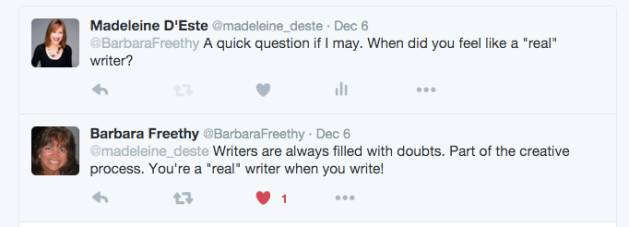
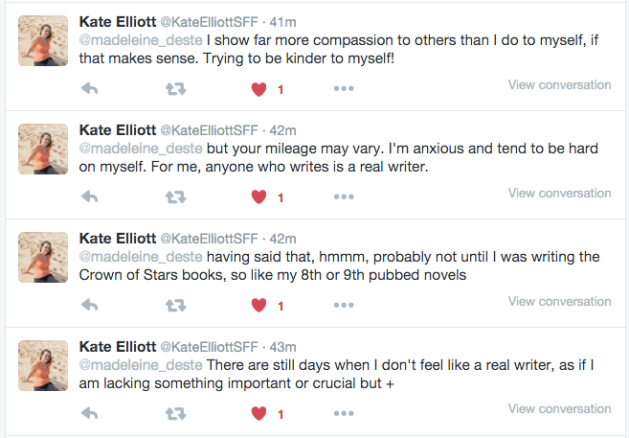
You’re a real writer when you write!
Words of wisdom!
I have one more answer up my sleeve, which I will post with a wrap-up of all the comments.
I hope you’ve enjoyed the pithy insights so far.
Now being selfish and competitive is generally seen to be a bad thing, but these two negative traits helped me go from a lump of words to a “finished” manuscript.

Books don’t write themselves. I work full time but I find time to write because I’m selfish. Writing is really important to me, so it takes priority over other stuff. I’ve learned to be comfortable saying “no”.
I’m also competitive. Now I’m associating with an online community of writers and every day, my fellow writers are launching books, getting agents, getting publishing deals and 5 star reviews. I’m happy for them, (I believe in abundance not scarcity) but I want what she’s having.
Tomorrow – Tip#8 Listening to my gut.
After feedback from Melanie Bernard, I’ve taken a slightly different angle today and asked my question to indie-published writers too.
The question again…
When did you feel like a “real” writer?
Today,

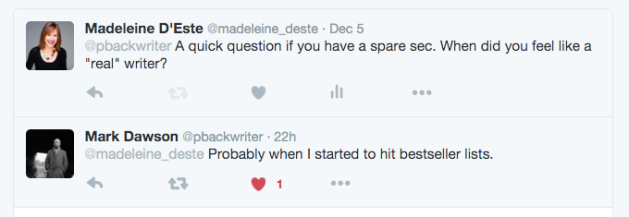
The number 5 again? Does something magical happen at Book 5?
I would start feeling like a “real” writer too, if I had Mark’s success.
Tomorrow, another two authors answer my question.
A professional needs their tools. The two tools which really helped me to compile and edit my unwieldy lump of words were Scrivener and Speech Function/Text to Speech.

Scrivener is software designed for writers to easily format long documents. It has lots of nifty features. My favourite is the left hand navigation where you can save chapters or scenes in folders and easily swap things around. I also love the target word count feature, with a satisfying little “ping” to congratulate me on reaching my daily word count. I’m probably only using a fifth of the features, but now it’s an essential part of my writing.
Speech Function/Text to Speech reads my words aloud to me. This is invaluable in the editing process. Read aloud, it’s easier to locate missing words, typos and clumsy phrases invisible to the eye. There is also a choice of voices, so I swap between an older British woman to a younger American man depending on my mood.
Tomorrow – Tip #7 Being Selfish and Competitive
Another couple of writers answer my question…
When did you feel like a “real” writer?
Today

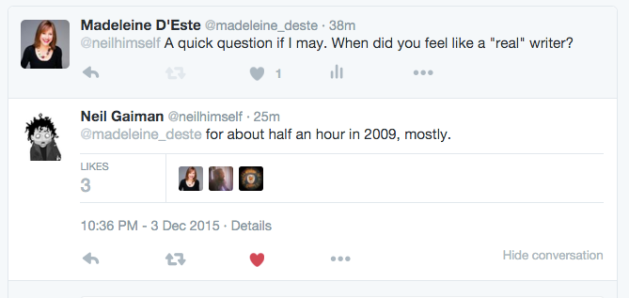
Was it 1982 or 2009 for you?
Tomorrow, another two writers answer my question.
Not the German electro band, in order to improve my craft, I sought wisdom from writing gurus. Tips and advice on how to be a better writer, storyteller and editor.

Over the past two years, my three main reference points have been
Story and Stein on Writing are available as audio books and the Story Grid is now a podcast.
I’ve listened to the audio over and over again, revisiting different sections as I need for wherever I’m up to in my writing. I heartily recommend all three.
Tomorrow – Tip#6 Loading my Tool Box
Two more great writers answer my question…
When did you feel like a “real” writer?
Today
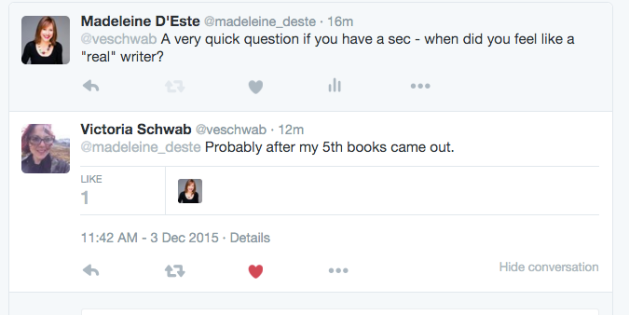
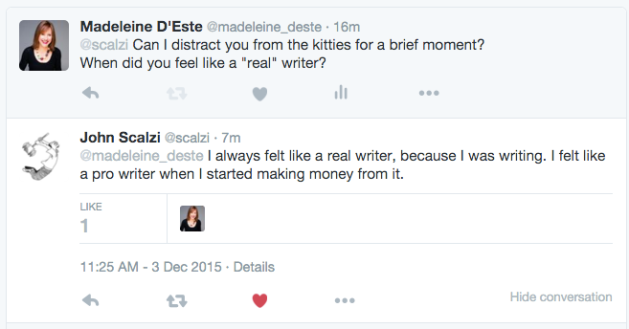
Two different perspectives here. Do you need money or being published to feel like a “real” writer?
Tomorrow, another two authors answer my question.
Resistance is the evil force standing between me and everything I want. He’s the naughty voice in my ear telling me stay on the couch, just another episode or have another slice, you deserve it.
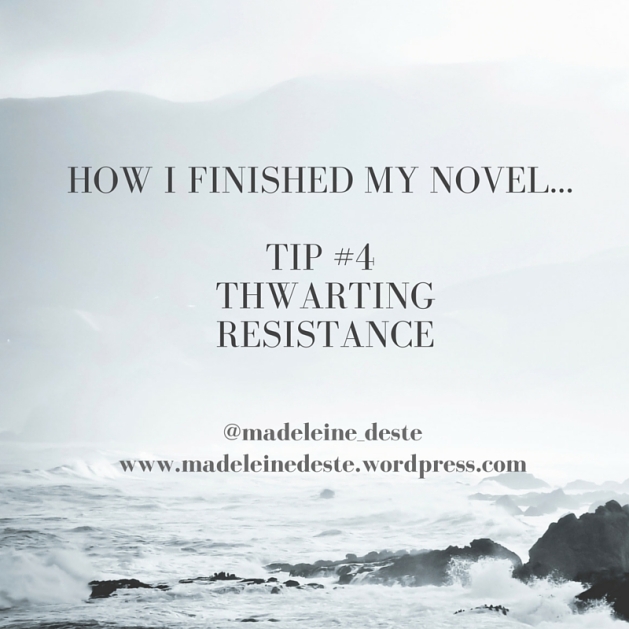
Resistance is mean and wily. He changed tactics and got stronger the closer I got to finishing. He told me I was wasting my time and I’m no good. He filled my head with fears I was going to stuff up my manuscript and I don’t have the talent to finish this.
Once I became conscious of Resistance and his mean tricks (thanks to War of Art), I am vigilant. I know what he’s up to.
I have my defences ready.
I just ignore him and keep going.
Tomorrow – tip #5 Craft Work
Another couple of brilliant writers answering my question…
When did you feel like a “real” writer?
This time I annoyed Joanne Harris and Ben Aaronovitch. A little bit of self-deprecating self-doubt and Daleks.
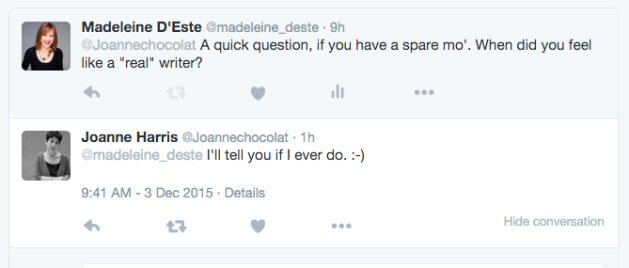

Did Ben mention Daleks?
Tomorrow, another two writers answer my question.
When I’m in full on editing mode, I go cross-eyed. I can’t see “the wood for the trees.”
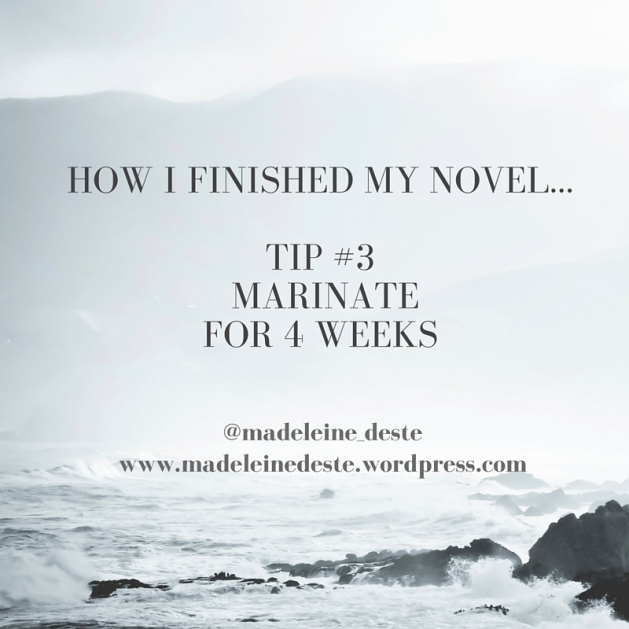
Putting aside my writing to “marinate” is important. Like marinating meat, putting your writing aside makes the flavours richer.
I’ve got a bad memory and when I put something away in the drawer, I completely forget the details. After a period of a month or so, I regain some objectivity about my work. I can see flaws and where to focus next.
And on occasion, I’ve been pleasantly surprised by my own work. Hoorah!
Tomorrow – Tip#4 Thwarting Resistance.
A few blog posts ago, I decided that I wanted to ask authors when they felt like a “real” writer. It appears that doubt is a continuing trait for writers and I wanted to hear from the sources.
Since then, I’ve been bothering my favourite writers on the internet asking this question.
When did you feel like a “real” writer?
Today I’m sharing responses from Gail Carriger and Val McDermid.


Scary but interesting to hear how successful writers still feel like “imposters”.
I have responses from another six brilliant writers, so stay tuned for their responses.
Writing takes up loads of time and not everyone understands the highs and the lows. Sometimes I need someone to whinge to!

While my off-line support team are brilliant, finding a tribe of writers online has been really helpful.
The Monthly Writing Challenge twitter group has especially helped with accountability, habit-forming and general encouragement.
They understand when I’m having a writing day where the words are like pulling a pineapple from an orifice.
Tomorrow – Tip #3 Marinate for 4 weeks.
Discipline and routine isn’t sexy but it’s necessary. Books don’t write themselves. Unfortunately. But creating a daily writing habit really helped to finish my project.
With the help of the Monthly Writing Challenge, I developed a routine of writing or editing every day. Every single day. The Monthly Writing Challenge has a target of 500 words per day or 1 hour editing. (More about the Challenge in Tip#2). There’s an online spreadsheet to record your work efforts and a little bit of public accountability helps.

Now, daily writing and editing has become a habit.
For example, I wrote this blog post while at the hairdresser in order to get my 500 words down for the day. I’ve written in parks at lunchtime, at airports, dictated while walking and other weirdo behaviours to get my words in.
Generally, I’m a boringly structured person anyway (I’m an Upholder according to Gretchen Rubin’s framework) but having regular accountability has made the habit stick. Then the word counts and drafts follow.
Tomorrow – Tip#2 Finding my Tribe
My manuscript “Return to the Monolith” is now in line editing. Hoorah! Eek. This means I’m done.
Disclaimer – I am “finished” for now. I don’t have an agent or publisher and I’d be naive to think there’ll be no more changes until the book appears in print.
Being “finished” is a peculiar feeling. I sat for ten minutes with my finger hovering over the send button, debating with myself. Am I really done? Is this it? Strange.
Anyway, it’s time to look back on two years of work and think about what I’ve learned.
This is the first in a series outlining what helped me to “finish”. I’ve come up with eight little helpers.
Over the next eight days, I’ll share eight tips.
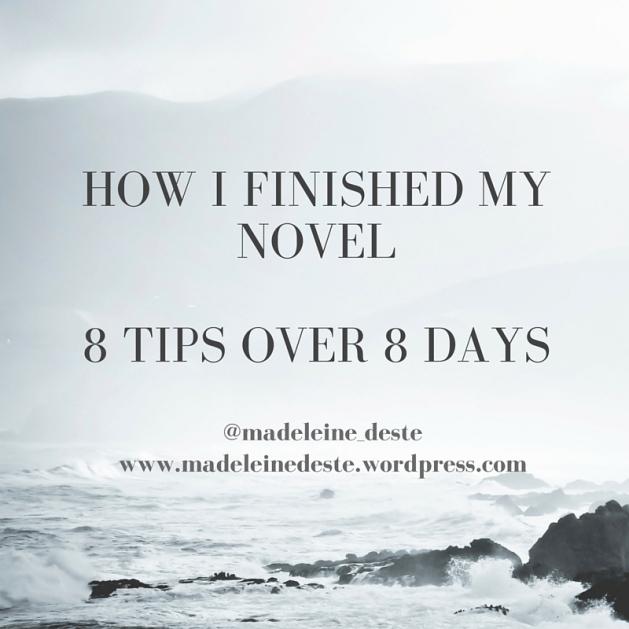
There’ll be a lot of you Nanowrimo-ans out there, with a big lump of words, wondering how to take your draft to the next stage. I hope this might help.
Tomorrow – Tip#1 : Discipline is not a dirty word..

Hoorah! Another Nanowrimo win! Little happy dance and then back to the word mines.
Nanowrimo is fun but I prefer the less pressure of the Monthly Writing Challenge (500 words per day target). It’s less stressful and creates more quality words. Meh, but that’s me.
So if you are not on board with the Monthly Writing Challenge, check it out and we’ll be keeping up the momentum into December.
Hope your Nanowrimo is going well!
I’ve been nominated by Beverley Lee to answer the following questions as part of the Siblinghood of the World Blogger awards. I answer 10 questions, then I pose 10 more questions to 10 more bloggers. Here we go…
I can’t narrow it down to one writer.
The more I grow as a writer, I realise we all share the same self-doubt and struggles with wrangling our stories. So the one question I’d like to ask all writers I admire is…
When did you feel like a “real” writer?
Which fictional character would you want as a friend, and why?
Nightingale from the Rivers Of London series. I want my own immortal magical mentor with impeccable pre-war dress sense. I imagine him being like Bill Nighy.
How’s that for a weird combo.
I think my influences are from the opposite side. I know what I dislike, so I avoid that type of writing. I have a background in the corporate world and business writing, so my style is simple. I don’t like overly flowery writing because I’m a lazy reader. The style is important to my reading pleasure. Some styles (and writers) do my head in and so I quickly switch to something cleaner.
Starting today, I’m writing the next novella in my Evangeline steampunk series. This novella is about seances and spiritualists.
She is in serious trouble of being typecast, but from the recent Dr Who episodes playing Ashildr/Me, I can absolutely see Maisie Williams as my character Alga from the Monolith series.
A good cover is so bloody important. There are some serious ugly covers out there, especially in the self-publishing world, but I’ll admit, often I don’t read the back blurb. There have been many times when I’ve been wowed by an early plot twist, then later on read the back blurb.
Before I buy or borrow (library love), I have to read a page at random. There are certain flowery styles of writing which I can’t handle (see above answer).
China Mieville’s Bas-Lag world from Perdido Street Station. What’s not to like …aliens, steampunk and magic. Mieville’s world building is crazy detailed and luscious. I feel I could step right into the pages and live there.
Absolutely. Words and books are to be shared. Share the love.
Let’s go back to my favourite kooky melodramatic Canadian redhead.
It’s been my experience that you can nearly always enjoy things if you make up your mind firmly that you will.
Thank you Anne Shirley and L.M. Montgomery.

I’m not quite sure how many nanowrimos I’ve done. I first heard of the fun crazy challenge in 2002 or 2003 from a friend in London. I’ve done at least four, I can remember.
My profile is from my days as a closet writer and apparently you can’t change your profile name. So find me under madolescent.
Nanowrimo taught me how to vomit draft.

Now I don’t get writer’s block, I keep on writing and writing. Filling the page with words even though it’s rubbish and sometimes it feels like I’m only typing.
But this way, the words get down and somehow in amongst the rabid typing, the magic happens.
I’ve been tagged by Aura Eadon to answer the following questions arising from Nicolette Elzie‘s blog.
Aside from the grey period when law school sucked out all the joy, I’ve always loved books and reading. But I never thought I could be a writer. I wasn’t creative or deep enough. Yet the need to create stories niggled at me for years. I’ve done Nanowrimo, attended a few short courses and produced five or six half-finished novels but never had the confidence to take myself seriously. Then during some maudlin navel gazing, I realised writing a novel was my life’s ambition. So I decided to get serious and come out as a writer.
I like to make stuff up so speculative fiction is my genre. A bit sci-fi but no spaceships. A bit fantasy but no ‘chosen ones’. I’ve tried writing in other genres (urban fantasy, crime etc) but the stories did not feel right. It did not feel like me. Speculative fiction is a comfy place to be.

I’ve got a full production line going with four or five pieces in various stages of drafting, editing and resting. My Monolith trilogy has been my main focus for the past eighteen months but I’m taking a break and currently working on a set of steampunk YA novellas set in 1880s Melbourne. My heroine is a 17 year old ex-pickpocket and acrobat now living in the Colonies with her long-lost father.
There was the cringe inducing poetry published in the school magazine, featuring thinly veiled phallic imagery. Good times.
Reaching the magical flow state, when the story takes over and ideas appear out of nowhere. I am just the implement recording the words on the page. It’s pretty damn cool.
When everything I write is a steaming pile of poo and the vicious voices whisper in my ear, telling I have no talent and I’m wasting my time.
Anne of Green Gables. Manic, kooky and fragile, she leaps from the page. She’s the inspiration for my steampunk heroine, Evangeline. Although in real life, Anne would get on my nerves. Such a drama queen.
I’m one of those annoying A-type personalities. Since I decided to get serious, I write or edit every day. But writing is my happy place. In an ideal world, I’d spend every morning writing. But in real life, I write whenever and where ever I get a chance.
Nope. I’m ambivalent about writing degrees. For me, writing is about discipline and practice. Can those skills be taught in a class at university? I’ve done short courses in the past. Now I read writing reference books and try to read critically.
Spelling errors. They stand out like a big angry zit.
“The most important thing about art is to work. Nothing else matters except sitting down every day and trying.” – Steven Pressfield
The Creative Penn, Story Grid, Steven Pressfield, Chuck Wendig. Encouragement comes from the brilliant Monthly Writing Challenge crew on Twitter.
I spend a lot of time in my head and sitting on my bum, so I try to balance this out with walking, running and weight training. I love to lose myself in books and films.
Three way tie between Perdido Street Station – China Mieville, Parable of the Sower – Octavia E Butler and Sunne in Splendour – Sharon Penman. Speculative fiction in three different ways.
Cheap Thrills – a twisted movie about what people will do for money.
Of all time? Too hard. Currently I’m into Ben Aaronovitch’s Rivers of London series. Recently completed Book 5 – Foxglove Summer and anxiously awaiting #6.
Depends on the direction of the wind and what I’ve had for breakfast. I’ve mentioned a few authors above. Other honourable mentions include Val McDermid, CJ Sansom and Michael Robotham.
Hopefully to start querying my Monolith trilogy by the end of the year. Exciting times. Wish me luck!
I’m in the first weeks of a new novel. Actually it’s Book 3 of my Monolith series.
I don’t believe anyone ever suspects how completely unsure I am of my work and myself and what tortures of self-doubting the doubt of others has always given me – Tennessee Williams
While many of the characters are familiar old friends and the world is a place I know well, I’ve transitioned from ‘close to final’ edits (fingers crossed) of Book 1 to a brand new blank page.
My brain is comparing my poorly structured Book 3 vomit draft with my almost complete Book 1.
Next to Book 1 with its 18 months of hard graft and polish, Book 3 feels like a steamy pile of poo. I am the super hack.
But misery loves company.
Rather than cheer myself up with positive quotes and affirmations, I’ve collated a bunch of other doubters. Doubters who are much more successful than me.
What still concerns me the most is: am I on the right track, am I making progress, am I making mistakes in art? – Paul Gauguin
Self-doubt is part of the process.
No fine work can be done without concentration and self-sacrifice and toil and doubt. – Max Beerbohm
So I’ll acknowledge it and…

It’s time for part four of my “revisiting childhood favourites” series with The Little White Horse by Elizabeth Goudge.
Maria Merryweather is an orphan (of course) and sent to live with her long lost uncle in the West Country at Moonacre Manor. She takes the long journey by carriage through the night with her bilious governess and Wiggins, her grumpy spoiled spaniel. Her new home is mysterious, mythic and magical. Her uncle tells tales of the tragic love story of the Moon Princess and Sir Wrolf, the first Merryweather, and of course the rarely seen little white horse.
Firstly it must be said, this book should be mandatory reading for anyone interested in glorious world-building. The descriptions of Moonacre Manor and its characters are vibrant and rich. From cosy cave houses and circular bedrooms in towers to a curmedgeonly dwarf with a rich vocabulary baking fairy cakes and lavish descriptions of hearty country meals (very reminiscent of Enid Blyton) to a cat that can write and the grumpy spoiled Wiggins, the spaniel.
But the story itself is a little strange. The haughty Maria bullies her family (both immediate and estranged) into complying with her wishes. All the while maintaining a relationship with a shepherd boy which no one questions. And this is supposedly 1842. There is much talk of “wicked men” and yet she converts them to goodness with harsh words and pearls. Reality aside, she is a firebrand who gets what she wants. A feisty female protagonist.
But the pleasure in this book is the imaginative world-building. If you are interested in descriptions or characterisation, I urge you read this book. Especially the first few chapters as Maria explores her new home.

One of the curious things about my writing life is I write sci-fi but I don’t often read it. I’ve recently made an effort to read some “masterworks” to fill my gaps.
Don’t you hate it when you find a brilliant “new” writer, only to find out they are already dead? I’m definitely late to the Octavia Butler party, the trail blazing African American female sci-fi writer. Before reading a word of her work, only her bio, I was filled with deep respect for Butler.
First I read Bloodchild (mainly because it was free and I am cheap). I thoroughly enjoyed the story of the alien host and her human servants. Although reading the end notes, I jumped to the conclusion (like many others) that it was a story about slavery. Apparently not!
Then while on a recent trip to the US, I came across Parable of the Sower in a bookshop. The luxury of holidays gave me time to devour it quickly. If I’d been at home (and not required to be social), I would’ve curled up in a corner until I finished it.
In Parable of the Sower, Lauren is 17 and lives in a neighbourhood compound in post-apocalyptic Los Angeles. Her father is the local preacher and community leader where the neighbours band together to keep themselves safe from the dangers outside the walls. The outside world is dangerous, filled with drug addicts who revel in fire.
Lauren listens to her father’s sermons but she has her own ideas about what God is. Over time her thoughts formulate in her mind, she is creating her own religion. It is called Earthseed.
One night, the compound and Lauren’s world is breached. She leaves and must fend for herself on the highways of California, looking for safety and a new life. All the while, building on her ideas for a new faith.
But the Parable of the Sower is much more than a dystopian road story.
As an aspirant writer, this is one of those books that made me want to put my pen down and give it all away. The prose so crisp and precise. The concepts so big and mind-chewing. This is what I want to be when I grow up.
As I said in my review of AYTGIMM, I’m ignorant about religion. The Parable of the Sower passage from the Bible has no meaning to me. I brought no preconceived ideas when I started reading.
With the chaos around her, Lauren sees God as objective. God is change and cares only about survival. There is no moral overlay about right or wrong. It just is. This reminds of the concepts in Nassim Nicholas Taleb’s Antifragile. Another book which wowed me.
I was struck by a single line. “Some people see nature as God.” Pow. There’s my worldview in a nutshell in a way I’d never considered it before. The way some people see God is the way I see nature/the universe. Awe inspiring and all powerful. But like Lauren, I never placed the moral overlay on nature. She doesn’t care about you and me as individuals. She only wants to continue on.
This book has stayed with me for months now. What more can you ask for in a book? Entertainment plus a soul searching challenge on your view of the universe.
Blog posts have been a little tardy. I’ve been distracted by the main game, my fiction. But let’s return to my favourite childhood books.
The next book in my series revisiting childhood classics is from Judy Blume. A classic children’s writer, I remember her books fondly. But funny how your memory plays tricks on you.
Time and memory are true artists; they remould reality nearer to the heart’s desire – John Dewey (1859-1952)
As an 80s child, my reading life was chock full of Judy Blume. I owned a copy of Starring Sally J Friedman As Herself. (This could explain why a kid in Tasmania in the late 1980s was reading biographies of old film stars like Lana Turner. Although as a voracious reader, I did work my way through most of the books in my small local library.)
Blubber. Super Fudge. Forever was the taboo book when I was in Grade 6, to be hidden from the parents under the mattress because it had s.e.x in it.
Then of course Are You There God? It’s Me, Margaret (AYTGIMM). The quintessential book on growing up. So today, I’m revisiting my old friend, Margaret.
Margaret has just moved to Jersey from NYC and she’s eleven. The child of a Jewish father and a Christian mother, she has grown up without religion, yet she talks to God every night. Margaret has a new school, new friends and new womanly body to manage.
Before I started to read this book, my memories of AYTGIMM were all about bras and periods. I expected it to be full of female body stuff. A fiction version of Everygirl. But on re-reading, I was surprised to discover that puberty is only one part of the story. The more important storyline is Margaret’s spiritual search. Is she Jewish or is she Christian? Who is this God she speaks to?
Looking at the title of this book, the religious element is completely obvious. Like Margaret, I grew up without religion, but I never went through a religious curiosity phase like she does. Margaret chooses to explore religion as the topic of her year long school project. As a child, this part of the story must not have resonated with me. Perhaps the difference is the overt religious tension in Margaret’s family. Or I blocked it out and focused on the juicy stuff.
AYTGIMM was probably the first time I read about someone like me, dealing with their newly adult bits, bras and periods, secret clubs and talking on the phone for hours about (very important) nothing. The “Two Minutes in a Closet” brought back cringe worthy memories of my own Grade 6 parties. Did we get the idea from this book? Although we used an ensuite bathroom. It brought back memories of my own experiences of being eleven.
The stand-out characters were Sylvia, Margaret’s grandmother and Laura Danker. Interfering and vibrant, Sylvia sounds like a super fun grandma but incredibly infuriating for Margaret’s mother. Laura Danker is a tragic innocent character. An early developer, the world makes assumptions about her morals just because she has boobs.
I didn’t enjoy AYTGIMM as much as I thought I would. The puberty stuff is of no interest anymore and neither is the religious angle. But I hope this book still resonates with eleven year old girls wondering what’s going on with their bodies and making sense of religious tension in their family. Just not for me.
Next book in line is The Little White Horse by Elizabeth Goudge. Apparently I’m in good company as this is also a favourite of JK Rowling.

This post is inspired by Chuck Wendig’s Terrible Mind blog. He put out a flash fiction challenge to write about “why I write?”
Here’s my story of “Why I write”.
I was a kid into books. I love stories. I love to be lost in books and transported by words. But I used to think storytellers were other people. Not me. They were artists. Artistic, high lit, tortured poetic wordsmiths. When I dashed down some words on a page, they were plain old crap.
It took years to learn lesson#1.
The first draft of anything is shit – Ernest Hemingway
So I hid the shit in a drawer and went back to watching TV.
But the desire still ate away at me. Whenever I thought about my life goals – writing a book was always number one with a bullet. So I’d enrol in some writing courses. I’d dabble but never had the confidence to take myself seriously.
I’d get discouraged and distracted.
Then I found Nanowrimo. Nanowrimo helped me churn out three or four unfinished lumpy novels. I proved to myself I could sit down and write 50,000 words in a month but they didn’t work. They didn’t resonate with me. My urban fantasy felt too cheesy. When I tried to write crime, my skin crawled when I tried to get inside the heads of serial killers or murderers. I was an imposter, none of it felt truly like me.
So I put it away again and went back to post-grad study.
Try not. Do, or do not. There is no try – Yoda
I started to get all angsty, mid life crisis riddled. My life circumstances changed and I had a bit of time on my hands. I imagined dying tomorrow with this one ambition left unfulfilled. It would be my one regret.
So I sat down and did it.
This time, it’s war – Aliens (1987)
Now I realise I need it. Practising every day, I’m learning the craft and improving. I read and learn from others. I’m prepared. I know it’s a bumpy ride of “I suck. I rock.” I know that the vomit draft is the easy part, the hard part is the six months of Revise. Delete. Rewrite. Repeat. I know the odds are stacked against me, there are millions of books published every day competing for readers. I know all this and I do it anyway. Cos I love it and it makes me happy.
That’s why I write.
 Michael Whelan’s Yours Truly
Michael Whelan’s Yours Truly
The next book in my series of revisiting childhood favourites is Anne of Green Gables by L.M. Montgomery.
Ah the memories…when I opened the first few pages of Anne of Green Gables, I was transported back to Grade 5 and my small primary school library in Launceston, Tasmania where I first borrowed this book. All the iconic phrases made me smile; the puffed sleeves, the alabaster brow, kindred spirits, bosom friends. I can see why people travel to Prince Edward Island today to see where Anne lived.
If you haven’t read or seen Anne of Green Gables, basically it’s the story of an eleven year old orphan* who is mistakenly sent to live with a gruff brother and sister in Avonlea on Prince Edward Island. The brother and sister really wanted a boy to help with the farm work but instead Anne arrives, filled with wild imaginative romantic notions and who cannot stop talking.
Reading Anne of Green Gables again was an absolute joy. I had forgotten what a wonderful character she is, so quirky and irrepressible. Despite her terrible childhood prior to moving to Avonlea, Anne is optimistic. An uneducated orphan, she built a fertile imagination to cope. But Anne is not all sunshine and lollipops, she’s feisty and stubborn. She stands up for herself and others if she feels she is being mistreated. There is no doubting why this is an absolute classic, Anne is such an endearing character who leaps off the page.
The novel travels through Anne’s life from aged eleven to over sixteen. Anne doesn’t just flounce about the countryside for 300 pages. We see Anne mature, and to some extent, conform. Towards the end of the book, where Anne buckles down to study hard for her examinations, I missed the quirky, nutty, overly emotive Anne. She makes tough decisions in the end, particularly hard decisions for a sixteen year old. Compared to the Blyton boarding school books where the characters are of similar ages, Anne grows up and makes adult decisions, unlike the protected girls from St.Clare’s.
Side note – Were 17 year olds really teaching school in Canada in the early 20th century?
Like Blyton, there are very few men in Anne of Green Gables too. Only the man-of-few-words Matthew and her number one rival, Gilbert Blythe. Anne is surrounded by strong, opinionated and capable women.
From a structural perspective, I wondered whether this book was originally a serial. The structure is very episodic, with 10 page self-contained chapters, perfect for a quick 15-20 minute read before bed or perhaps designed for reading to children. The structure reminded me of a TV series with the “story of the week” with its beginning, middle and end, plus a thin thread of overarching story. I’m now inspired to try this structure myself… one day. I’ve already got 5 novels in the works at the moment, in various stages from Draft#7 at 100k words to a paragraph of jotted thoughts. Maybe in 2018?
All in all, Anne of Green Gables stands up as a wonderful read and truly worthy of its classic status.
What’s next? Get ready for the real side of blossoming womanhood. It’s time for bras and periods with Are You There God, It’s Me Margaret.
Do you have fond memories of Anne with an e?

*What’s with orphans in childhood literature? I’m sure there’s a million PhD theses on this topic.
I’m terrible at book monogamy. I got distracted from my reading of Anne of Green Gables (the new shiny thing is Kim Newman’s The Quorum) for my blog series revisiting my favourite children’s book, so no review today. Although I am enjoying spending time with that feisty nutty Anne Shirley again.
Today’s blog post is about research. Or three random research topics for my current manuscript. I needed to describe the call of a hawk, find out what was inside an elite soldier’s survival pack and the different parts of a barrel. My writing is educational too!
This site has written descriptions of bird calls, as well as audio clips to listen for yourself. Perfect for describing the screech of a hawk overhead, which is kee-eeeee-arr, if you were wondering. Those twitchers are cool people.
My current manuscript includes a secret military operation to bring back a fugitive. So I needed to know what is in a standard issue survival kit for a Navy SEAL. This article in Time shows the current contents as well as the contents in the packs from 1960s.

Did you know that the wooden planks forming the main body of a barrel were called “staves”? I do now.

Here’s the first instalment of a new blog series where I revisit my favourite children’s books, beginning with Enid Blyton’s The O’Sullivan Twins.
Good old Aunty Enid is the grand dame of influences. A little passe and politically incorrect these days but Blyton was the influence for me. From Noddy to The Enchanted Wood to the Famous Five to the Naughtiest Girl/St.Clares/Mallory Towers series, Blyton was my author.



I owned a large illustrated copy of The Enchanted Wood and dressed up as Silkie for Book Week (another reference to Book Week dress-ups in a future blog post). The Famous Five probably whet my appetite for mysteries and I also remember the 70s telly series fondly. Sing along with me now… “George and Timmy the dog..”
I loved most of Enid’s book but her boarding school books were my absolute favourite. Maybe I need some therapy to understand why. I loved the idea of midnight feasts, “short sheeting”, French prep, being “sent to Coventry” and lacrosse. I longed to go to boarding school and devoured all of these books.
Then I re-read the O’Sullivan twins…
I don’t spend much time in the children’s section of bookshops, so I was shocked at the number of Enid Blyton books still on the shelves. I thought in these days of Harry Potter, YA and MG galore, Aunty Enid would be less popular. Wrong.
From the first few lines of The O’Sullivan Twins, I was transported back. The words and the character were so familiar. How many times had I read this before? I giggled along at the quintessentially British language and the tropes. It was all there; midnight feasts, “bricks” and “old girls”, lacrosse matches, French prep, descriptions of cake and “being sent to Coventry”. The now sensible O’Sullivan Twins return to St.Clare’s for their second term, this time accompanied by their “feather-headed bleating” cousin Alison.
But as I progressed through the book, I was transported back to the feelings of a tweenie. I was shocked by the way the girls treat each other, there’s an awful lot of bullying in this book. Girls ganging up on each other, gossiping and isolating individuals for their “mean and spiteful” behaviour. And this is exactly what I remember about being a tweenie.
This is a moral tale for playing by the rules and conforming. Margery is the sullen outsider who redeems herself and teaches the twins a lesson about assumptions. I was surprised how old the girls were (fourteen to sixteen). The girls at St.Clare’s lead a terribly sheltered life, yet there is tragedy and teen angst, father-daughter relationships, family accidents and poverty. Aside from their fathers and one mention of a gardener, there are no men in the world of St.Clare’s. Is that what Blyton was trying to do? Create a series of books to teach young women the right way to behave in WW2 Britain?
With my writer hat on, I was surprised at the “head-hopping” or point of view changes within the same paragraph. I thought ‘head-hopping’ was a big no-no. But if Aunty Enid can do it…?
When I finished the last page and said goodbye to my old friends, my feelings on boarding school have changed. I couldn’t think of anything worse than going to St.Clare’s with all the bullying and conformity. But I am hankering for an afternoon tea with “Buns and jam! Fruit cake! Meringues! Chocolate eclairs!”
What are your memories of Enid Blyton?
I was pulling together a series of blog posts on my top 5 most influential books of my childhood and an idea struck me. Why not re-read all five books and review them with adult eyes.
So I’ll be reading and blogging about….

All female writers too.
Look out for the posts in the weeks to follow….
I’m callous and caustic, love stories leave me cold. I’ve never pictured a perfect wedding, knights in shining armour, being swept off my feet (surely that would hurt?) or living happily ever after.
In fact, I actively avoid rom-coms or romance novels. I hate the part in a comedy movie when the laughs stop and the lovey-dovey, vomit-inducing stuff takes over. Blurgh, give me spaceship battles or fights any day.
So, how did I find myself witnessing a scene straight from a rom-com, blossoming moment by moment in front of my eyes?
I arrived at the communal study room of my local library, looking for a little quiet editing time out of the house. The room was crammed with studious people, barely a spare seat, I took the last seat next to a guy. I didn’t look at him, but I glanced across to see what he was working on/studying. I’m nosy like that. He was doing Japanese homework.
I put in my headphones and booted up my lap top, ready to work, when an announcement came over the PA system. The library wifi was down. I opened up Scrivener and plugged on regardless, hoping the wifi would come back soon.
Five minutes later, another announcement. The wifi would be down for the rest of the afternoon. I decided to persevere, with the music-less headphones in my ears (editing Book 2 Return to the Forest). One by one, the other people left the study room.
Then the guy next to me struck up a conversation with the girl on the other side. Miffed at first for disturbing my peace, my stickybeak nature couldn’t help but eavesdrop. He was studying Japanese and she turned out to be a Japanese exchange student, freshly arrived in Melbourne. They exchanged phrases, she corrected and praised his Japanese, he helped with her English. They giggled and continued to talk.
As the room emptied, I moved to another spare table, but glanced over to check them physically. Was he a dirty old man and she a young girl? No, they were well suited, both slim, young and a little nerdy.
Over the next half hour, they moved closer and closer together, while the rest of the room emptied. Arms touching, hunched over their homework.
My editing time was up, so I packed to leave, but as I left the room, I wondered about the Japanese student and the Australian guy, imagining a happy ever after.
Perhaps I’m not as callous as I thought.

I have never been one to commit to books, or movies or TV shows. I can walk away at any time, even just a few moments before the end. If it hasn’t grabbed my attention, I can move on. No qualms. Maybe I’m just a commitment phobe.
But now as I’m spending hours and hours of my time writing and editing, every time I put aside a book for something newer and shinier, I have second thoughts. A little tinge of guilt…should I feel bad when I abandon reading a book?
 www.booyorkcity.com
www.booyorkcity.com
I feel for the writer, now that I have some idea of the process. The hours, weeks, months and years poured into crafting every single word. Sometimes I feel bad for skimming over sentences, thinking back to my last writing session, where I laboured for forty five minutes over a single sentence. A sentence some callous reader could just skip over!
Then I think about how the writer made it through the gauntlet of the publishing world (although a lesser consideration these days with the thriving indie market), through the anguish of finding an agent and getting selected by a publisher. If it made it through the publishing gauntlet, it must be good, right?
Life is short. There are so many other books I could be reading. There are so many other fish in the sea. If it isn’t doing it for me, I should move on guilt-free.
This does not mean the book is bad. It just isn’t right for me at this moment. If I’m in the mood for a mystery with a hunchback lawyer from the 15th century, then an urban fantasy with a mixed race London bobby in the magical division is not going to cut it.
Of course, reading anything after a fantastic book is hard. Rebounds are always fleeting.
Other times, I’ve abandoned a book only to pick it up again later and devour it. Sometimes I’ve just got to be in the right mood.
After this conversation with myself, I’ve decided I don’t need to feel guilty about abandoning a book. It’s not you book, it’s me.
Are there any songs about Thursdays? I can’t think of any.
As an exercise in documenting my imagination fuel, I spent a day noting down interesting sights, sounds and topics for future writing. Inspiration is everywhere and you never know where the next gem might crop up.
You get ideas from daydreaming. You get ideas from being bored. You get ideas all the time. The only difference between writers and other people is we notice when we’re doing it. ~ Neil Gaiman
As I walked to work, I caught sight inside a fire damaged building. The news stories said the fire was suspicious. I peeked inside (actually I stopped and had a proper gawk) at the smoke damaged walls, the blackened beams, the smashed skylights, the missing first floor, the piles of debris, the grey, white and black.
A vibrant green male ballet dancer jumping the air with a flowing cape from the Australian Ballet’s production of a Midsummer Night’s Dream. Here’s the image from the poster.
A “crane giraffe” killer cockroach from 100 million years ago has been found preserved in amber. Sounds like the premise of a horror movie to me.
This might be some kind of brand or a bikie gang, but my imagination went to a tale of brotherhood and family rivalry.
Note: turns out my memory is faulty and this is a US metal band and their name is Avenged Sevenfold. Good name though.
Sit down, open my laptop, crack my knuckles and go!
And then stare at the blank page…sometimes, it’s not that easy to get going.
Here’s a couple of other things I do before I start writing –
Stretch
Whether a few yoga poses, some arm circles or a walk around the block, I need a bit of movement before I put fingers to keyboard.
Have you got a spare three minutes? Here’s a little three minute video of Japanese morning calisthenics (also known as raijo taiso). I do this every morning to knock out the kinks. Apparently, raijo taiso is broadcast across Japan every morning. Originally part of an insurance company campaign in the 1920s, it is still popular today. Some say, it is the secret to the spritely Japanese elders.
Ode to the Muse
Next, I invite the Muse to join me with my writing.
This is the beginning four lines of a beautiful poem Ode to the Muse written by Mary Darby Robinson from an anthology from 1791.
O, LET me seize thy pen sublime
That paints, in melting dulcet rhyme,
The glowing pow’r, the magic art,
Th’ extatic raptures of the Heart;
How could the Muse ignore such a delightful invitation?
Writing warm ups
Now to get the brain moving with a few quick writing warm ups. Something short and sharp, but a little bit hard.
As cities get bigger and more people move to find work, pressure on housing increases. Tiny apartments is one solution.
Like all interior design porn, small apartments get attention. The perfectly minimalistic Nordic designed tiny space with only the bare essentials.
A micro-apartment for James Bond perhaps?

Or a pristine serene monk cell? But where do you put the telly?

That is all nice for a photo shoot but how do people really live when they only have 10sqm (300 sf), or less, of space.
Look at Hong Kong…

…where whole families live in similarly small space.


…or live in bunk like storage cages.

It’s not just in Hong Kong, here’s an example in London

Dystopia is here already.
Powered by WordPress & Theme by Anders Norén